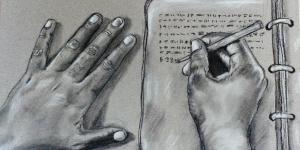You are here
Who Was the Angel in Heaven with the Everlasting Gospel that John Saw?

Revelation 14:6
The Know
Just over 200 years ago, the angel Moroni appeared to the young Joseph Smith on the evening of September 21, 1823. Throughout the night, Moroni instructed Joseph Smith about a record written on gold plates and buried nearby. Joseph Smith would eventually translate this record by the gift and power of God as the Book of Mormon.
The visitation of Moroni to Joseph Smith has traditionally been interpreted by Latter-day Saints to be a fulfillment of one of the events that John saw and recorded in the Book of Revelation. According to John, he “saw another angel fly in the midst of heaven, having the everlasting gospel to preach unto them that dwell on the earth, and to every nation, and kindred, and tongue, and people” (Revelation 14:6). This angel would also come to announce that “the hour of his judgment is come” (Revelation 14:7), therefore preparing the world for the Lord’s second coming.
As noted by Duane S. Crowther, many aspects of this prophecy connect neatly to the angel Moroni, as the angel in Revelation is said to (1) come bringing the everlasting gospel; (2) “he said he would bring the gospel with him,” implying that he would come in a time of apostasy; (3) this gospel would be preached throughout the world; (4) he would come before the hour of God’s judgement; and (5) the angel’s message would “include the admonition to worship and fear the creator of heaven and earth.”1 As such, although additional fulfilments of this prophecy can be observed, “these five points combine to give clear indication that the coming of Moroni on September 21, 1823,” offered one powerful fulfilment of this prophecy “in a complete and literal manner.”2
First, just as this angel had “the everlasting gospel” to preach to those on the earth, the Lord sent Moroni to Joseph Smith, declaring that “I have sent [him] unto you to reveal the Book of Mormon, containing the fulness of my everlasting gospel” (Doctrine and Covenants 27:5). The designation of the Book of Mormon as containing the everlasting gospel was apparently made known to Joseph Smith during Moroni’s visits throughout the night, as Joseph later reported, “He [Moroni] said there was a book deposited, written upon gold plates. … He also said that the fulness of the everlasting Gospel was contained in it, as delivered by the Savior” (Joseph Smith—History 1:34). That is to say, Moroni’s first meeting with Joseph Smith was directly connected to sharing the everlasting gospel, just as the angel in Revelation was prophesied to do.
Second, this announcement came at the end of a long period when precious things had been lost from the Gospel and covenants had been taken away (1 Nephi 13:27-29). Through Joseph Smith, the Lord restored His church and His gospel. The Book of Mormon, the everlasting gospel delivered by Moroni, was critical in that process, as important truths regarding the nature of mankind and the plan of salvation were restored to the earth. As such, Joseph Smith could rightly declare, “Take away the book of Mormon, and the revelations, and where is our religion? We have none.”3
A third component to the fulfilment of this prophecy, as noted by Crowther above, is that the gospel would be sent “to every nation, and kindred, and tongue, and people” (Revelation 14:6). The Book of Mormon came forth to speak to “every nation, kindred, tongue, and people.”4 And for that reason, the Three Witnesses proclaimed their testimony of the angel and the Book of Mormon plates “unto all nations, kindreds, tongues, and people, unto whom this work shall come.”5 Latter-day Saints today participate in the fulfillment of this aspect of the prophecy, as implied in a revelation given in November 1831 that uses language from Revelation 14:6–7 (see D&C 133:36–37). As Richard D. Draper and Michael D. Rhodes have noted, in this revelation the Lord “broadens the interpretation to include not only Moroni but also all Church members serving in their callings as missionaries who are taking the teachings of that book and a warning message to all the nations of the earth.”6
Fourth, many of Moroni’s instructions to Joseph Smith involved quoting scriptures from the Old and New Testaments regarding the need to prepare for the Lord’s coming (see Joseph Smith—History 1:36–41).7 Furthermore, according to Joseph Smith, Moroni “informed me of great judgments which were coming upon the earth, with great desolations by famine, sword, and pestilence; and that these grievous judgments would come on the earth in this generation.” (Joseph Smith—History 1:45). The Book of Mormon likewise contains many injunctions to prepare for the Second Coming of the Lord so that we may stand before God.
Finally, Moroni’s message was ultimately, as John prophesied, directed for us to “Fear God, and give glory to him … and worship him that made heaven, and earth, and the sea, and the fountains of waters” (Revelation 14:7). Speaking about the Book of Mormon, Joseph Smith taught that “a man would get nearer to God by abiding by its precepts than any other Book.”8 As such, it is a message to point us to Christ, so that we might know “that Jesus is the Christ, the Eternal God, manifesting himself unto all nations” (Title Page to the Book of Mormon). Such, ultimately, is the reason the gospel has always been shared.
Another notable aspect about this angel, as revealed in D&C 133:36, includes how he “hath appeared unto some,” thus showing that multiple people have had divine experiences with this angel prior to 1831. Many early Saints have recorded meeting an angel in connection with the plates, such as the Three Witnesses or Mary Whitmer.9 This angel is often presumed to be Moroni due to his role as the guardian and revealer especially of the “everlasting” gospel contained in the Book of Mormon.10
Of course, like other prophecies, this prophecy in Revelation 14 could likewise have multiple fulfilments. Joseph Smith, for example, stated that “the Lord in the last days would commit the keys to a witness over all people.” After quoting Revelation 14:6, Joseph Smith then remarked that “John saw the angel having the priesthood who should preach.”11 This has led Jay A. Parry and Donald W. Parry to observe that “Moroni certainly had the priesthood, but he did not commit any priesthood keys—that was done by Peter, James, and John, Elijah, Moses, and others (D&C 110; 128:20–21),” as well as John the Baptist, who restored the Aaronic priesthood (D&C 13).12
The Why
When John began writing his revelation, he was instructed to “write the things which thou hast seen, and the things which are, and the things which shall be hereafter” (Revelation 1:19). Because of this instruction, it is clear that many of his writings pertain to events that had not yet happened as he wrote. Naturally, then, his prophecies are especially important to Latter-day Saints and others living in turbulent times.
Due to the timing of this angel’s appearance, it is especially evident that this angel pertains to the last days. While never identified by name in the Revelation, clear fulfilments of this prophecy can be found in the history of The Church of Jesus Christ of Latter-day Saints. Heavenly messengers, including Moroni, John the Baptist, Peter, James, and even John the Revelator himself, as well as others, came bringing essential components to the everlasting gospel that was to be preached to the entire world.
As this gospel is found within The Church of Jesus Christ of Latter-day Saints, it is important to recognize the importance of this prophecy’s fulfilment beginning in 1823, over 200 years ago. As the angel Moroni appeared, serving as the first major fulfilment of this prophecy, he revealed information about the Book of Mormon, which Moroni had himself completed and sealed up, and which now has been translated into over a hundred languages and published to people all over the world. Indeed, it is clear that the everlasting gospel is being shared with “every nation, and kindred, and tongue, and people,” as countless faithful Saints are working to flood the earth with the Book of Mormon.
Further Reading
Richard D. Draper and Michael D. Rhodes, The Revelation of John the Apostle (Provo, UT: BYU Studies, 2013), 343–352.
Jay A. Parry and Donald W. Parry, Understanding the Book of Revelation (Salt Lake City, UT: Deseret Book, 2007), 183–184.
H. Donl Peterson, Moroni: Ancient Prophet, Modern Messenger (Salt Lake City, UT: Deseret Book, 2000), 164–172, 178–179, 182–184.
- 1. Duane S. Crowther, The Prophecies of Joseph Smith (Bountiful, UT: Horizon, 1983), 59–60.
- 2. Crowther, Prophecies of Joseph Smith, 60.
- 3. Minute Book 1, p. 44, The Joseph Smith Papers.
- 4. See Mosiah 3:13, 20; 15:28; 16:1; Alma 37:4; 45:16.
- 5. The Testimony of Three Witnesses, front of the Book of Mormon.
- 6. Richard D. Draper and Michael D. Rhodes, The Revelation of John the Apostle (Provo, UT: BYU Studies, 2013), 349.
- 7. Joseph Smith recorded that Moroni quoted Malachi 4, Isaiah 11, Acts 3, and Joel 2, among “many other passages of scripture.”
- 8. Remarks, 28 November 1841, p. 112, The Joseph Smith Papers.
- 9. See, for example, the Testimony of the Three Witnesses; Book of Mormon Central, “What Does Mary Whitmer Teach Us About Enduring Trials? (2 Nephi 27:14),” KnoWhy 455 (August 2, 2018); and H. Donl Peterson, Moroni: Ancient Prophet, Modern Messenger (Salt Lake City, UT: Deseret Book, 2000), 164–172, who identifies at least 16 individuals who have had encounters with Moroni.
- 10. The word “everlasting” is frequently used throughout the Book of Mormon. While “the gospel” is mentioned many times in the New Testament, “the everlasting gospel” appears only in Revelation 14:6, as observed by Draper and Rhodes, The Revelation of John the Apostle, 548.
- 11. Discourse, 12 May 1844, as Reported by Thomas Bullock, p. 1, The Joseph Smith Papers.
- 12. Jay A. Parry and Donald W. Parry, Understanding the Book of Revelation (Salt Lake City, UT: Deseret Book, 2007), 184. Elder Bruce R. McConkie has also suggested that this angel seen by John could be symbolic for many angels: “the angel Moroni brought the message, that is, the word; but other angels brought the keys and priesthood, the power,” each being critical components of the everlasting gospel.” Bruce R. McConkie, Doctrinal New Testament Commentary, 3 vols (Salt Lake City, UT: Bookcraft, 1983), 3:530.
KnoWhy Citation
Related KnoWhys
Subscribe
Get the latest updates on Book of Mormon topics and research for free





